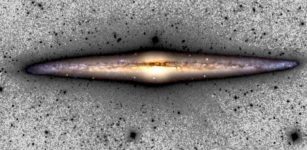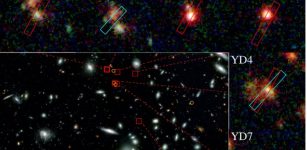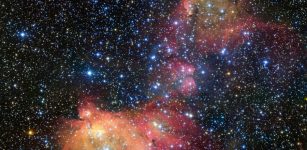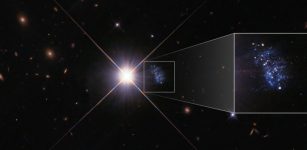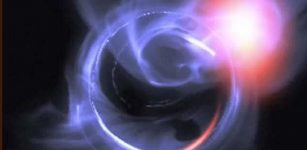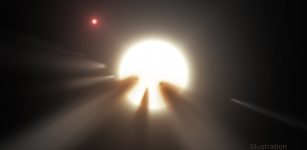Study Of Theia 456 Shows Its Nearly 500 Stars Were Born At Same Time
Eddie Gonzales Jr. – MessageToEagle.com – The Milky Way houses 8,292 recently discovered stellar streams — all named Theia. But Theia 456 is special.
A stellar stream is a rare linear pattern — rather than a cluster — of stars. After combining multiple datasets captured by the Gaia space telescope, a team of astrophysicists found that all of Theia 456’s 468 stars were born at the same time and are traveling in the same direction across the sky.
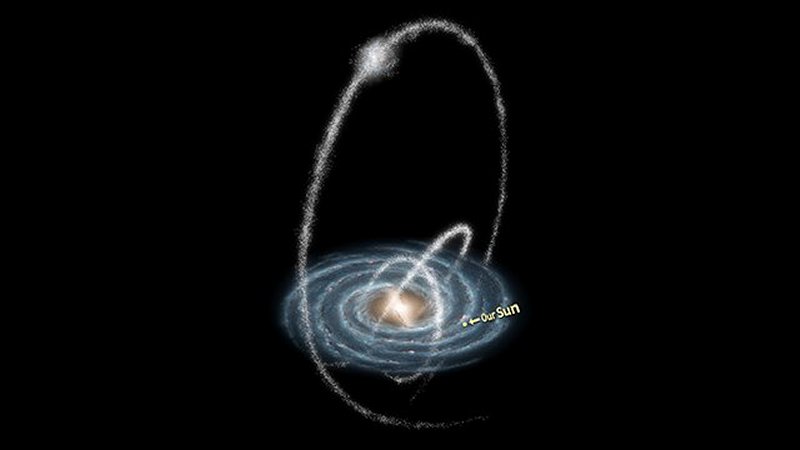 An artistic rendering of generic stellar streams in the Milky Way. Credit: NASA/JPL-Caltech/R. Hurt, SSC & Caltech
An artistic rendering of generic stellar streams in the Milky Way. Credit: NASA/JPL-Caltech/R. Hurt, SSC & Caltech
“Most stellar clusters are formed together,” said Jeff Andrews, a Northwestern University astrophysicist and member of the team. “What’s exciting about Theia 456 is that it’s not a small clump of stars together. It’s long and stretched out. There are relatively few streams that are nearby, young and so widely dispersed.”
While researchers have long known that stars form in groups, most known clusters are spherical in shape. Only recently have astrophysicists started to find new patterns in the sky. They believe long strings of stars were once tight clusters, gradually ripped apart and stretched by tidal forces.
“As we’ve started to become more advanced in our instrumentation, our technology and our ability to mine data, we’ve found that stars exist in more structures than clumps,” Andrews said. “They often form these streams across the sky. Although we’ve known about these for decades, we’re starting to find hidden ones.”
Stretching more than 500 light-years, Theia 456 is one of those hidden streams. Because it dwells within the Milky Way’s galactic plane, it’s easily lost within the galaxy’s backdrop of 400 billion stars. Most stellar streams are found elsewhere in the universe — by telescopes pointed away from the Milky Way.
“We tend to focus our telescopes in other directions because it’s easier to find things,” Andrews said. “Now we’re starting to find these streams in the galaxy itself. It’s like finding a needle in a haystack. Or, in this case, finding a ripple in an ocean.”
Identifying and examining these structures is a data science challenge. Artificial intelligence algorithms combed huge datasets of stellar data in order to find these structures. Then Andrews developed algorithms to cross-reference those data with pre-existing catalogs of documented stars’ iron abundances.
Andrews and his team (astrophysicists Marcel Agüeros and Jason Curtis of Columbia University, Julio Chanamé of Pontifica Universidad Catolica, Simon Schuler of University of Tampa and Kevin Covey and Marina Kounkel of Western Washington University) found that the 468 stars within Theia 456 had similar iron abundances, which means that — 100 million years ago — the stars likely formed together.
Adding further evidence to this finding, the researchers examined a light curves dataset, which captures how stars’ brightness changes over time.
“This can be used to measure how fast the stars are spinning,” Agüeros said. “Stars with the same age should show a distinct pattern in their spin rates.”
With the help of data from NASA’s Transiting Exoplanet Survey Satellite and from the Zwicky Transient Facility — both of which produced light curves for stars in Theia 456 — Andrews and his colleagues were able to determine that the stars in the stream do share a common age.
The team also found that the stars are moving together in the same direction.
“If you know how the stars are moving, then you can backtrack to find where the stars came from,” Andrews said. “As we rolled the clock backwards, the stars became closer and closer together. So, we think all these stars were born together and have a common origin.”
Andrews said combining datasets and data mining is essential to understanding the universe around us, you can only get so far with one dataset,” he said.
“When you combine datasets, you get a much richer sense of what’s out there in the sky.”
Written by Eddie Gonzales Jr. – MessageToEagle.com Staff




